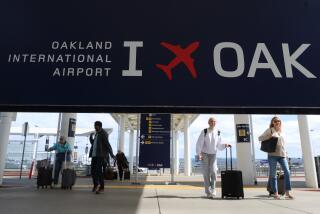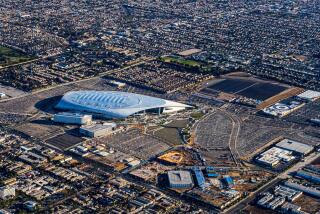Muffling Airport Noise Is Complex and Baffling
- Share via
Almost anyone who lives or works in the urban areas of San Diego County is used to hearing airplane noise. With the North Island and Miramar Naval air stations and all the civilian airports, including busy Palomar and Montgomery Field, the skies above us are constantly dotted with aircraft, some of which can be disruptive, depending on weather conditions and our proximity to them.
But living near Lindbergh Field under the flight pattern of departing jets is an experience in a class by itself. Those who only occasionally visit residential areas such as Loma Portal, or even talk with people there by telephone, are sometimes shocked to learn just how intrusive the noise from departing jetliners can be. The airport is considered to have the worst noise problem of any in California and operates under a variance that allows it to violate state noise standards.
As the airport has become busier over the years, the bitterness of those who must contend daily with the nerve-wracking noise has deepened. This has led to lawsuits against the San Diego Unified Port District, owner of the airport, and a series of attempts to otherwise get the port to do something to reduce the noise level. The noise issue, along with questions about safety at Lindbergh Field and about whether it can accommodate the future growth of air traffic in the region, fuels interest in finding another site for San Diego’s commercial airport.
But, putting aside for now the question of moving the airport, the port district must take action to give some immediate relief to those living in the flight paths. Port District commissioners currently are weighing a proposal to extend the existing nighttime curfew on departing flights by 90 minutes, moving the deadline for take-offs from 11:30 to 10 p.m.
Meanwhile, consultants to the Port District have proposed altering the departure routes and pressuring the airlines to use more of the so-called Phase III, quieter jets at night. And recently the Marine Corps Recruit Depot, which leases some of its adjacent property to the Port District for part of the runway, has joined the fray, threatening to boycott commercial airlines that refuse to fly all the way to the end of the runway before turning north over MCRD.
All of these ideas and issues deserve serious attention. Indications are the Federal Aviation Administration would not approve a change in the departure route, in part because it would mean more work for air traffic controllers. Naturally, safety factors must govern any decision. The proposal of extending the curfew to 10 p.m. also seems premature.
Although we do not share the concerns of some of those in the tourist industry that airlines will leave San Diego if restrictions here become too much of a burden, we do believe that such an early curfew would inconvenience too many travelers and would give San Diego the image of a city that rolled up its sidewalks shortly after sundown.
On the other hand, the Port District should wield a very firm hand in requiring airlines to use more of the quieter jets during the late-night hours. While the airlines can’t snap their fingers and convert their entire fleets at once, San Diego must fight for its fair share of the newer planes. The consultants’ suggestion of giving the airlines until 1991 to phase in quieter jets is a most reasonable one.
As for MCRD’s complaints, there seems to be no reason other than bureaucratic non-responsiveness for that problem not to be solved quickly. While everyone involved--the Port District , the airlines and the FAA--all stare at their shoe tops and mutter that it’s not their fault, the Marines, who live closest to the runway, are having their sleep and their work violently disrupted by the deafening noise.
More to Read
Sign up for Essential California
The most important California stories and recommendations in your inbox every morning.
You may occasionally receive promotional content from the Los Angeles Times.










